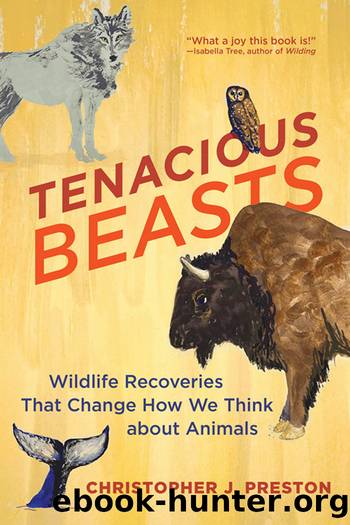Tenacious Beasts: Wildlife Recoveries That Change How We Think about Animals by Christopher J. Preston

Author:Christopher J. Preston [Preston, Christopher]
Language: eng
Format: epub
Tags: wildlife; conservation; nature; extinction; biodiversity; wildlife recovery; climate change; ecology; whales; sea otters; bison; wolves; salmon; dams; hatcheries; beavers; spotted owls; Marsican bears; wildcats
Publisher: MIT Press
Published: 2023-02-27T00:00:00+00:00
3âPRUNING APPLES FOR BEARS
I was struggling to keep pace with Mario Cipollone as he hustled up a steep trail in the central Apennines of Italy. We were heading through a cold rain toward an abandoned shepherd's cabin in the Monte Genzana Reserve. Fallen beech leaves made a tawny carpet as we crossed a wooded ridge at four thousand feet. Wolf scat by the side of the trail provided a clue these rugged hills concealed wildlife far larger than I was accustomed to seeing in England.
As we descended the other side of the ridge, the thirty-eight-year-old conservationist, his hair cropped short atop his muscled physique, scanned the dripping forest for something he wanted me to see.
âThere!â he said, pointing toward a tree with a familiar look. âApple! See how our volunteers have pruned it?â
The gnarled trunk was a relic from the time these hills were cultivated by Italian farmers, before they abandoned their fields at the end of the Second World War. Volunteers under Cipollone's guidance had removed the dead wood and opened the tree to the light to stimulate the growth of fruit. The apples from these harvests were not for the markets in nearby villages but for the bellies of one of the region's most notorious residents: the Marsican brown bear.
âWe don't talk about these apples a lot,â Cipollone confessed with a sheepish grin. âRewilders aren't supposed to be pruning trees.â
Cipollone and his partner, Angela Tavone, who joined us on the hike, work for Salviamo lâOrso, an organization devoted to protecting the highly endangered Apennine bear. As people have left this part of LâAquila, big animals, including the elusive bear, have nosed their way back. Most Marsican bears reside within a network of national and regional parks. In recent years, they have increased in number and started to explore the abandoned farmlands and orchards on the edges of the picturesque villages. Cipollone and Tavone are helping smooth their return.
The work I witnessed on behalf of the Marsican bear is innovative and effective. A rare and charismatic animal is coming back from the brink. But pruning apple trees for the benefit of bears is an almost heretical type of intervention. Italy packs a lot of people into very limited space. Wandering around the edges of human habitation is a startling array of large animals. In the Washington forest and in Blean Woods, I had already seen wildlife managers being remarkably hands-on as they helped wildlife recover. Here was a different wrinkle on the same dilemma. How much intervention is acceptable when people and animals no longer have the space to live separate lives? Or, to put this in terms of what I had just seen, should Cipollone and Tavone be pruning apple trees to help grow bears?
* * *
The Marsican bear (Ursus arctos marsicanus) is one of the rarest of the world's fourteen or so subspecies of brown bear. (The exact number is still a matter of some debate.) The bears live at the geographical center of Italy, a country well-trampled by sixty million people.
Download
This site does not store any files on its server. We only index and link to content provided by other sites. Please contact the content providers to delete copyright contents if any and email us, we'll remove relevant links or contents immediately.
The Lonely City by Olivia Laing(4750)
Animal Frequency by Melissa Alvarez(4395)
All Creatures Great and Small by James Herriot(4233)
Walking by Henry David Thoreau(3894)
Exit West by Mohsin Hamid(3778)
Origin Story: A Big History of Everything by David Christian(3649)
COSMOS by Carl Sagan(3554)
How to Read Water: Clues and Patterns from Puddles to the Sea (Natural Navigation) by Tristan Gooley(3409)
Hedgerow by John Wright(3276)
The Inner Life of Animals by Peter Wohlleben(3259)
How to Read Nature by Tristan Gooley(3249)
How to Do Nothing by Jenny Odell(3232)
Project Animal Farm: An Accidental Journey into the Secret World of Farming and the Truth About Our Food by Sonia Faruqi(3177)
Origin Story by David Christian(3147)
Water by Ian Miller(3128)
A Forest Journey by John Perlin(3027)
The Plant Messiah by Carlos Magdalena(2883)
A Wilder Time by William E. Glassley(2818)
Forests: A Very Short Introduction by Jaboury Ghazoul(2790)
